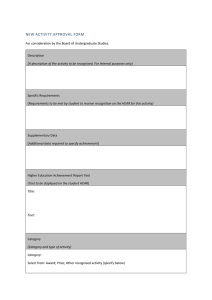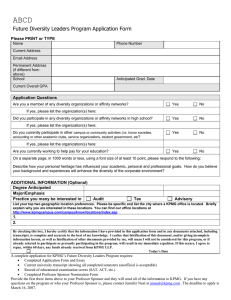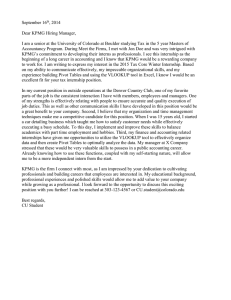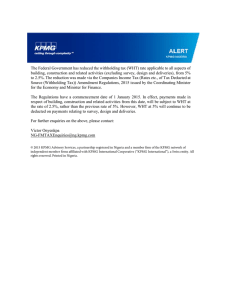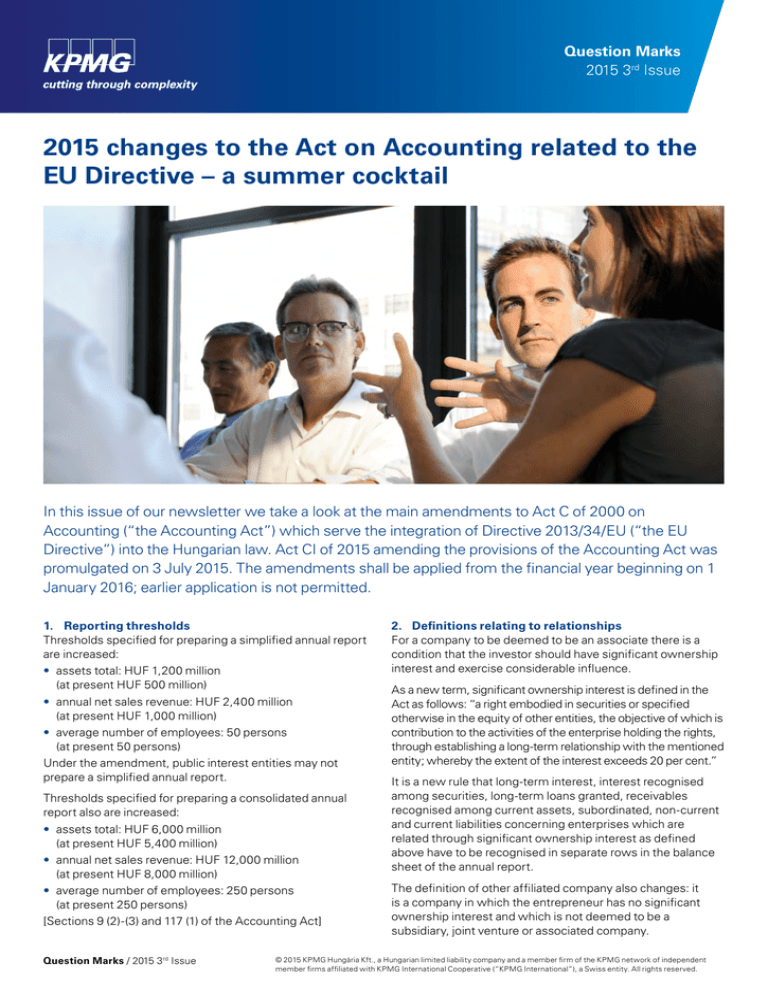
Question Marks
2015 3rd Issue
2015 changes to the Act on Accounting related to the
EU Directive – a summer cocktail
In this issue of our newsletter we take a look at the main amendments to Act C of 2000 on
Accounting (“the Accounting Act”) which serve the integration of Directive 2013/34/EU (“the EU
Directive”) into the Hungarian law. Act CI of 2015 amending the provisions of the Accounting Act was
promulgated on 3 July 2015. The amendments shall be applied from the financial year beginning on 1
January 2016; earlier application is not permitted.
1. Reporting thresholds
Thresholds specified for preparing a simplified annual report
are increased:
• assets total: HUF 1,200 million
(at present HUF 500 million)
• annual net sales revenue: HUF 2,400 million
(at present HUF 1,000 million)
• average number of employees: 50 persons
(at present 50 persons)
Under the amendment, public interest entities may not
prepare a simplified annual report.
Thresholds specified for preparing a consolidated annual
report also are increased:
• assets total: HUF 6,000 million
(at present HUF 5,400 million)
• annual net sales revenue: HUF 12,000 million
(at present HUF 8,000 million)
• average number of employees: 250 persons
(at present 250 persons)
[Sections 9 (2)-(3) and 117 (1) of the Accounting Act]
Question Marks / 2015 3rd Issue
2. Definitions relating to relationships
For a company to be deemed to be an associate there is a
condition that the investor should have significant ownership
interest and exercise considerable influence.
As a new term, significant ownership interest is defined in the
Act as follows: “a right embodied in securities or specified
otherwise in the equity of other entities, the objective of which is
contribution to the activities of the enterprise holding the rights,
through establishing a long-term relationship with the mentioned
entity; whereby the extent of the interest exceeds 20 per cent.”
It is a new rule that long-term interest, interest recognised
among securities, long-term loans granted, receivables
recognised among current assets, subordinated, non-current
and current liabilities concerning enterprises which are
related through significant ownership interest as defined
above have to be recognised in separate rows in the balance
sheet of the annual report.
The definition of other affiliated company also changes: it
is a company in which the entrepreneur has no significant
ownership interest and which is not deemed to be a
subsidiary, joint venture or associated company.
© 2015 KPMG Hungária Kft., a Hungarian limited liability company and a member firm of the KPMG network of independent
member firms affiliated with KPMG International Cooperative (“KPMG International”), a Swiss entity. All rights reserved.
Question Marks / 2015 3rd Issue
The definition of related company is narrowed: only parent
companies, subsidiaries and joint ventures are deemed related
companies. Associates are no longer deemed related companies.
[Section 3 (2) 4, 4a, 5, 7 and 9 of the Accounting Act]
3. Definition of goodwill
Unlike under the rules in force thus far, neither goodwill
nor negative goodwill can be recognised separately in the
standalone financial statements when the entity obtains
qualified majority influence through the acquisition of
interest in another company. Under the new rule, goodwill
and negative goodwill can only arise in standalone financial
statements, if the acquisition is realised through item-byitem recording of assets and liabilities (i.e. an asset deal). In
line with this, the consideration (purchase price) paid upon
purchase shall be considered the cost of the interest. As a
result of the transitional provision, the opening value of the
related interest in the 2016 financial year shall be adjusted
for the carrying amounts of goodwill and negative goodwill
recorded among the opening data of the financial year
beginning in 2016 that cannot be recognised separately under
the new rule.
[Sections 3 (5) 1 and 2; 49 (3); 141 (9) and 177 (46) of the
Accounting Act]
4. Goodwill
According to the amendment to the Accounting Act, goodwill
shall be amortised at least over 5 to 10 years, if its useful life
cannot be estimated.
The amendment does not stipulate whether amortisation
is required to be accounted for, and if so, according to what
schedule, in the case of goodwill that arose before the
amendment but may also remain in the books after the
amendment. The question arises whether:
- it is necessary to start accounting for depreciation for assets
that have not been depreciated so far, and
- it is necessary to modify depreciation, if the remaining
useful life of an already depreciated asset, when the
amendment enters into effect, is longer than 10 years.
The possibility to reverse extraordinary depreciation booked
on goodwill will no longer exist.
Deferred income recognised as negative goodwill can be
released against other income at least over 5 to 10 years from
the acquisition. The rule effective so far specified this period
as over 5 years or a longer period.
[Sections 45 (4); 52 (1), (4) and 53 (3) of the Accounting Act]
5. Types of income statement
Version “B” of the income statement (which has typically not
been used by companies) is removed, and only Version “A”
can be used. Entities can still choose between the methods
to analyse the expenses by nature or function.
[Section 71 (2) of the Accounting Act]
6. Income statement items
The category of extraordinary profit/loss and, accordingly,
profit/loss of ordinary activities will cease. The content of
extraordinary profit/loss shall be recognised among other
income/expenses or income from/expenses of financial
transactions, in accordance with its nature and content.
Another change is that, where applicable, profit or loss shall
be recognised among income or expenses on a net basis.
There will be changes to items included in profit from/loss
from financial transactions or to their names. Classification of,
for example, the following items will change:
• Exchange loss on the sale of interest has to be recognised
in a separate line of the income statement called
“expenses and exchange loss on interests” instead of the
line item “exchange loss on investments”;
• Impairment on long-term loans less reversal of impairment
booked previously has to be recognised as impairment on
interests, securities, bank deposits and long-term loans.
According to rules in force thus far, impairment on loans
granted had to be recognised among other expenses, while
reversal of impairment had to be recognised among other
income.
[Sections 77; 81; 83-86 and 87 (1) of the Accounting Act)]
7. Dividends
Dividends can be paid from available retained earnings
and shall be accounted for against retained earnings at
the company distributing the dividend as at the date of
the resolution approving the dividend. Under the rules in
force thus far, a dividend was payable from profit after tax
supplemented with available retained earnings and dividends
were required to be accounted for in the financial year of the
financial statements which formed the basis of the decision
concerning the dividend. In line with this, the category of
retained profit/loss for the year will be removed and the last
line item in the income statement will be profit/loss after tax.
When calculating the dividend payment threshold and the
owner’s equity in excess of the subscribed/registered capital
(in the case of repurchase of treasury shares and the increase
of subscribed/registered capital from other elements of
equity), the positive valuation reserve shall be taken into
account as a deductible item; however, the equity cannot be
adjusted for the negative valuation reserve.
Based on the amendment to the Accounting Act, it is not clear
whether the entity receiving the dividend may recognise the
dividend in the financial year if the resolution on the dividend
is passed only between the reporting date and the balance
sheet preparation date. The uncertainty is caused by a joint
interpretation of the following two provisions. On the one hand,
under the amendment the dividend received (due) is the amount
due based on the resolution on the distribution of the profit after
tax, if it is known by the balance sheet preparation date. On the
other hand, when calculating the dividend threshold, a dividend
received (due) accounted for by the balance sheet preparation
date in the current reporting year that is not presented in the
financial statements for the previous financial year can be taken
into account as an item increasing equity.
[Sections 35 (7); 39 (3)-(5); 40 (1); 40/A (7) and 84 (1) of the
Accounting Act]
Question Marks / 2015 3rd Issue
8. Prior-year data of the balance sheet and the income
statement
In accordance with the above changes the balance sheet and
income statement items as well as their content are changed.
In financial statements for the 2016 financial year the prioryear data of the balance sheet and the income statement
have to be presented reclassified in accordance with the new
requirements.
[Section 177 (45); Appendices 1-6 of the Accounting Act]
9. Content of the accounting policies, supplement and
business report
The content of the accounting policies is expanded. In
the case of annual reports the scope of information to be
disclosed in the supplementary notes and presented in the
business report is expanded, while in the case of a simplified
annual report the scope of data to be disclosed in the
supplementary notes generally is narrowed.
10.Other changes
• Public interest entities will not be entitled for exemption
from the audit obligation based on their size as provided by
Section 155 (3) of the Accounting Act. [Section 155 (5) f) of
the Accounting Act]
• The content of the auditor’s report is changed regarding the
business report and the corporate governance statement.
[Section 156 (5) h)-j) of the Accounting Act]
• An entrepreneur or an enterprise that is a parent company
operating in the raw materials extraction industry or
engaged in timber exploitation of natural forests has to
prepare each year a standalone or a consolidated report
on amounts paid to governments, if the entrepreneur is
deemed a public interest entity or its ratios exceed the
specified thresholds and it cannot be otherwise exempted.
[Sections 134/A – 134/C of the Accounting Act]
[Sections 14 (4) and 88-96 of the Accounting Act]§]
Endnote
Unlike other issues of our newsletter, in this case we did not raise questions but summarised the amendments to the Act on
Accounting we deemed substantial. To keep things brief, we did not undertake to provide a comprehensive picture of the new
rules, therefore a full understanding of the new and amended rules may require familiarisation with the legal regulations and
the EU Directive. If the amendments to the legal regulations gave rise to questions for you, we recommend that you contact
your tax or accounting advisor, or contact us.
Contact
Judit Boros
Partner
T: +36 1 887 7196
Ágnes Rakó
Director
T: +36 1 887 7438
KPMG Hungária Kft.
Váci út 31. H-1134 Budapest
E: kerdojelek@kpmg.hu
László Kajtár
Partner
T: +36 1 887 7324
The information contained herein is of a general nature and is not intended to address the
circumstances of any particular individual or entity. Although we endeavour to provide accurate
and timely information, there can be no guarantee that such information is accurate as of the
date it is received or that it will continue to be accurate in the future. No one should act on
such information without appropriate professional advice after a thorough examination of the
particular situation.
The KPMG name, logo and “cutting through complexity” are registered trademarks or
trademarks of KPMG International.
© 2015 KPMG Hungária Kft., a Hungarian limited liability company and a member firm of the
KPMG network of independent member firms affiliated with KPMG International Cooperative
(“KPMG International”), a Swiss entity. All rights reserved.


